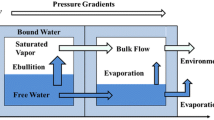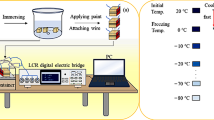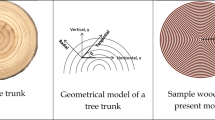Abstract
Dielectric heating is a promising process for the uniform sterilization of food products as well as for the drying of products. However, radio frequency heating of wood-based materials (a highly anisotropic material with temperature, moisture and structural orientation dependent properties) does not seem to be elucidated in the literature. It is within this framework that this study is carried out and concerns the modeling of anisotropic dielectric heating by radio frequency (RF) and its application to the thawing of frozen wood. The nonlinear heat conduction problem involving phase changes is formulated in terms of volume enthalpy. For the numerical resolution of the thermal conduction equation, the finite element method is considered. Thermophysical and dielectric properties are expressed as a function of temperature, moisture content (MC), and structural orientation. The numerical approach is further validated by a combination of the analytical, numerical and experimental analyses. Finally, the effect of RF on the thawing of the Douglas-fir (Pseudotsuga menziesii) and the white oak (Quercus alba), which are two North American wood species, was studied based on an initial temperature of − 20 °C and a frequency of 50 MHz. In this regard, two MC of 65% and 90% are considered. For the two species of the studied wood, it is observed that the RF induce a uniform temperature profile.




















Similar content being viewed by others

References
Annasabi Z, Erchiqui F (2020) 3D hybrid finite elements for anisotropic heat conduction in a multimaterial with multiple orientations of the thermal conductivity tensors. Int J Heat Mass Transf. https://doi.org/10.1016/j.ijheatmasstransfer.2020.119795
Asencor FJ, Panizo M (1992) Finite-difference operators in anisotropic inhomogeneous dielectrics: general case. J Comput Phys 95(2):387–399
Bhattacharya M, Basak T, Ayappa KG (2002) A fixed-grid finite element based enthalpy formulation for generalized phase change problems: role of superficial mushy region. Int J Heat Mass Transf 45:4881–4898
Bunge CA, Gries T, Beckers M (eds) (2017) Polymer optical fibres. Woodhead Publishing, Sawston. https://doi.org/10.1016/C2014-0-00562-X
Bunget I, Popescu M (1984) Physics of solid dielectrics. Elsevier, New York
Burch JB, Clark M, Yost MG, Fitzpatrick Cole TE, Bachand AM, Ramaprasad J, Reif JS (2006) Radio frequency non-ionizing in a community exposed to radio and TV broadcasting. Environ Health Perspect 114(2):248–253
Chandrasekaran S, Ramanathan S, Basak T (2012) Microwave material processing—a review. AIChE J 58:330–363
Chen Hollis C (1983) Theory of electromagnetic waves: a coordinate-free approach. McGraw-Hill, Blacklick
Coleman CJ (1990) The microwave heating of frozen substances. Appl Math Model 14:439–440
Dokainish MA, Subbraj K (1989) A survey of direct time-integration methods in computational structural dynamics-II. Implicit methods. Comput Struct 32:1371
Erchiqui F (2013) Analysis of power formulations for numerical thawing frozen wood using microwave energy. Chem Eng Sci 98:317–330
Erchiqui F (2014) Analysis and evaluation of power formulations for wood and hardboard using radio frequency and microwave energy. Drying Technol 32(8):946–959
Erchiqui F, Annasabi Z (2019) 3D hybrid finite element enthalpy for anisotropic thermal conduction analysis. Int J Heat Mass Transf 136:1250–1264
Erchiqui F, Annasabi Z, Koubaa A, Slaoui-Hasnaoui F, Kaddami H (2013) Numerical modelling of microwave heating of frozen wood. Can J Chem Eng 91(9):1582–1589
Erchiqui F, Annasabi Z, Souli M, Slaoui-Hasnaoui F (2015) 3D numerical analysis of the thermal effect and dielectric anisotropy on thawing frozen wood using microwave energy. Int J Therm Sci 89:58–78
Erchiqui F, Kaddami H, Slaoui-Hasnaoui F, Koubaa A (2020a) 3D finite element enthalpy method for analysis of phytosanitary treatment of, wood by microwave. Eur J Wood Prod 78:577–591
Erchiqui F, Kaddami H, Dituba-Ngoma G, Slaoui-Hasnaoui F (2020b) Comparative study of the use of infrared and microwave heating modes for the thermoforming of wood-plastic composite sheets. Int J Heat Mass Transf 158:996. https://doi.org/10.1016/j.ijheatmasstransfer.2020.119996
Fu Z, Avramidis S, Weng X, Cai Y, Zhou Y (2019) Influence mechanism of radio frequency heating on moisture transfer and drying stress in larch boxed-heart square timber. Dry Technol 37(13):1625–1632
Hu H, Argyropoulos SA (1995) Modelling of Stefan problems in complex configurations involving two different metals using the enthalpy method. Model Simul Mater Sci Eng 3(1):53–64
James WL (1975) Dielectric properties of wood and hardboard: Variation with temperature, frequency moisture content, and grain orientation, USDA Forest Service Research Paper, Forest Products Laboratory: Madison, WI
Kaestner PA, Bååth LB (2005) Microwave polarimetry tomography of wood. IEEE Sens J 5(2):209–215
Koumoutsakos A, Avramidis S, Hatzikiriakos SG (2001a) Radio frequency vacuum drying of wood. I. Math Model Dry Technol 19(1):65–84
Koumoutsakos A, Avramidis S, Hatzikiriakos SG (2001b) Radio frequency vacuum drying of wood. II. Experimental model evaluation. Dry Technol 19(1):85–98
Lazarescu C, Breuil C, Avramidis S, Maderas CT (2005) Phytosanitation of mountain pine beetle infected lodgepole pine using dielectric fields at radio frequencies. Cienc Tecn 17(2):221–228
Pozar MD (2011) Microwave engineering, 4th edn. Wiley, New York
Rattanadecho P (2006) The simulation of microwave heating of wood using a rectangular wave-guide: influence of frequency and sample size. Chem Eng Sci 61:4798–4811
Rattanadecho P, Suwannapum N, Cha-um W (2009) Interactions between electromagnetic and thermal fields in microwave heating of hardened type I-cement paste using a rectangular waveguide (influence of frequency and sample size). J Heat Transf ASME 131(8):082101
Soares D Jr, Vinagre MP (2008) Numerical computation of electromagnetic fields by the time-domain boundary element method and the complex variable method. CMES-Comput Model Eng Sci 25(1):1–8
Steinhagen HP, Harry W (1988) Enthalpy method to compute radial heating and thawing of logs. Wood Fiber Sci 20(4):451–421
Torgovnikov GI (1993) Dielectric properties of wood-based materials. Springer series in wood science, vol 33. Springer, Berlin
Acknowledgements
This work was done with the financial support of the Natural Sciences and Engineering Research Council of Canada (RGPIN-2016-05689).
Author information
Authors and Affiliations
Corresponding author
Additional information
Publisher's Note
Springer Nature remains neutral with regard to jurisdictional claims in published maps and institutional affiliations.
Rights and permissions
About this article
Cite this article
Erchiqui, F., Annasabi, Z. & Diagne, M. Investigation of the radiofrequency heating of anisotropic dielectric materials with a phase change: application to frozen Douglas-fir and white oak woods. Wood Sci Technol 56, 259–283 (2022). https://doi.org/10.1007/s00226-021-01345-y
Received:
Accepted:
Published:
Issue Date:
DOI: https://doi.org/10.1007/s00226-021-01345-y



